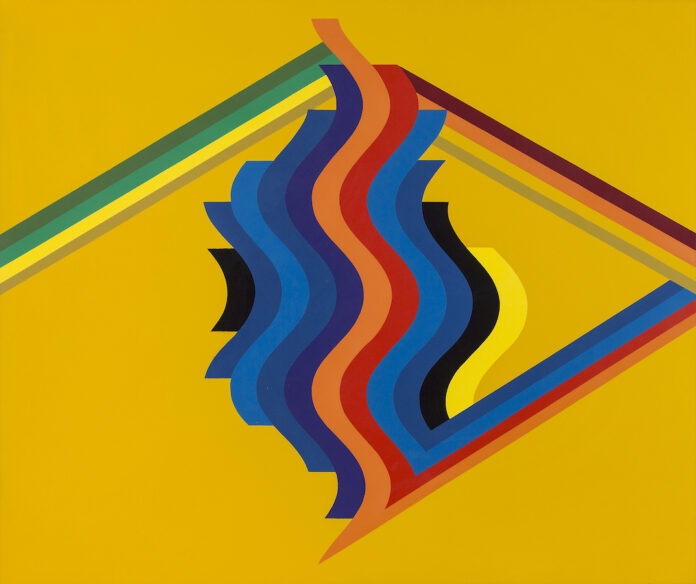Mohamed Melehi
Melehi features in one of MENART’s special exhibitions, “Casablanca School,” which “attempts to capture the inspiration that this movement launched between 1962 and 1971” in Morocco. “The Casablanca school was not limited to an architectural context nor the educational program of an art school. It was above all a movement in search of artistic and cultural modernity specific to Morocco. It was a socio-cultural positioning that challenged the Academic system of art education and the Euro-centered art history,” the MENART catalogue explains. “This group of artists engaged in a study bringing back the practice of traditional geometric abstraction and the use of signs and symbols characteristic to their Berber, Arab-Muslim, and African social culture. In addition, they used materials of their surroundings such as leather, metal, and natural pigments as their mediums.” Melehi, who died in 2020, was an iconic figure in North African modernism, his use of bright colors and geometric forms — as shown in this piece from 1975 — creating a dynamic style of his own.
Faisal Samra
The Bahrain-born Saudi artist’s career spans five decades, during which he has experimented with photography, painting, sculpture, film, and performance. He is widely regarded as a pioneer of conceptual art in the Middle East, and his work has progressed from expressionism, through “emotive and sensory approaches to art” to a stage where, according to a bio from his gallery, “he has rebelled against his own understanding of art, transitioning into new works that maintain three essential concepts: spontaneity, dynamism, and secrecy.” This untitled diptych, created this year, demonstrates one of Samra’s recurring themes, as he once explained to Elan magazine. “Dissolving is a big thing in my work,” Samra said. “Because we are temporary as humans; we appear then disappear. It is because of this that we want to make things; we want to make a mark. This tension between death and life gives us the motivation to do whatever we are doing.”
Youssef Nabil
The Cairo-born Egyptian photographer Youssef Nabil is one of the region’s most successful artists. His hand-painted photography portraits of famous cultural figures from the Arab world and the West have proved especially popular, while his later series of self-portraits have displayed the artist’s introspective side. At MENART, he presents this 2021 work, “Memories of a Happy Place.” “I’m working on a new series of self-portraits and landscapes. They are about my observation and interrogation of life and existence and about how fragile we all are. It’s a subject that takes up a lot of my thinking,” he told GQ Middle East last year.
Rashid Diab
The Sudanese artist spoke to Arab News in September last year about his lovingly created paintings of his homeland’s landscapes and people, many of which — like this piece from 2020 — portray figures moving through seemingly vast spaces. He said this was because he senses that many Sudanes people “don’t know what to do.” “It makes life surreal. I see the silence of the space in the desert with people fading or vanishing away. It is an uncertain life.” He wanted to honor the women of his country, he added. “Many women in Sudan have lost their husbands or kids; they have suffered a lot,” he said. “But they keep going. They are very strong. I show them respect when I paint them. These women have to be recognized.”
Sama Alshaibi
Iraqi multimedia artist Sama Alshaibi was born in Basra to an Iraqi father and Palestinian mother. It is no surprise, then, that her work — according to a bio written by Ayyam Gallery — “explores spaces of conflict and the power struggles that arise in the aftermath of war and exile.” It continues: “Alshaibi is particularly interested in how such clashes occur between citizens and the state, creating vexing crises that impact the physical and psychic realms of the individual as resources and land, mobility, political agency, and self-affirmation are compromised.”
Elias Moubarak
“The Levant is a region where both modern and contemporary artists have re-appropriated their chaotic and unstable daily lives and integrated them into their art,” the MENART brochure states. Notions of “territory, refugees and traditions” dominate their work, and Lebanon especially “possesses this singular ability to capture cultural flows from various sources and to play a role of mediation and filter for movements and styles, born in the West or elsewhere, in order to translate them into its own artistic frameworks.” Lebanese filmmaker and photographer Elias Moubarak, who lives in Germany, presents this haunting, untitled work from 2018 at MENART.
Abdulqader Al-Rais
Al-Rais is one of the UAE’s most-respected artists, known for his landscapes, architectural studies and abstract work, the latter earning him most acclaim. The septuagenarian is largely self-taught. According to the Sharjah Art Foundation, he is “known for both his abstract oil paintings — which draw on Arabic script and geometric forms — and his more recent landscape watercolors, which reflect his longtime interest in traditional Emirati architecture and nature.” This untitled work from 2020, on show at MENART, is a fine example of the former.
Yousef Jaha
A veteran and leader of the Saudi art scene, Makkah-born artist Yousef Jaha held his first solo exhibition back in 1987. At MENART, he is showing this untitled, muted oil painting from 2021. In a previous artist’s statement, Jaha said: “My works constitute a vital part of my personality, a kind of faith, confidence and innate expression of my internal concepts. Experience — and enjoyment — of this work must from inside, and leads to both a natural contemplation and an experience of the technological which expresses it.”

